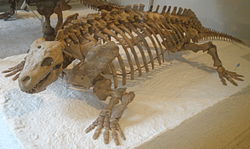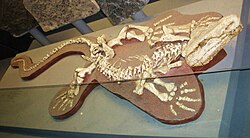
Back أشباه العضاضات العرضية Arabic Diadectomorfs Catalan Diadectomorpha German Diadectomorpha Spanish Diadectomorpha Basque سراسرخایندهریختان Persian Diadectomorpha French Diadectomorpha Italian Diadectomorpha Dutch Diadektomorfy Polish
| Diadectomorphs Temporal range: [1]
| |
|---|---|

| |
| Skeleton of Diadectes sideropelicus in the American Museum of Natural History | |

| |
| Skeleton of Limnoscelis paludis | |
| Scientific classification | |
| Domain: | Eukaryota |
| Kingdom: | Animalia |
| Phylum: | Chordata |
| Clade: | Reptiliomorpha |
| Order: | †Diadectomorpha Watson, 1917 |
| Subgroups | |
Diadectomorpha is a clade of large tetrapods that lived in Euramerica during the Carboniferous and Early Permian periods and in Asia during Late Permian (Wuchiapingian),[1] They have typically been classified as advanced reptiliomorphs (transitional between "amphibians" sensu lato and amniotes) positioned close to, but outside of the clade Amniota, though some recent research has recovered them as the sister group to the traditional Synapsida within Amniota, based on inner ear anatomy and cladistic analyses.[2][3][4][5] They include both large (up to 2 meters long) carnivorous and even larger (to 3 meters) herbivorous forms, some semi-aquatic and others fully terrestrial. The diadectomorphs seem to have originated during late Mississippian times, although they only became common after the Carboniferous rainforest collapse and flourished during the Late Pennsylvanian and Early Permian periods.
- ^ a b Jun Liu and Gabe S. Bever (2015). "The last diadectomorph sheds light on Late Palaeozoic tetrapod biogeography". Biology Letters. 11 (5): 20150100. doi:10.1098/rsbl.2015.0100. PMC 4455737. PMID 25948572.
- ^ Cite error: The named reference
:0was invoked but never defined (see the help page). - ^ Jozef Klembara; Miroslav Hain; Marcello Ruta; David S. Berman; Stephanie E. Pierce; Amy C. Henrici (2019). "Inner ear morphology of diadectomorphs and seymouriamorphs (Tetrapoda) uncovered by high‐resolution x‐ray microcomputed tomography, and the origin of the amniote crown group". Palaeontology. 63: 131–154. doi:10.1111/pala.12448.
- ^ Klembara, Jozef; Ruta, Marcello; Hain, Miroslav; Berman, David S. (2021). "Braincase and Inner Ear Anatomy of the Late Carboniferous Tetrapod Limnoscelis dynatis (Diadectomorpha) Revealed by High-Resolution X-ray Microcomputed Tomography". Frontiers in Ecology and Evolution. 9. doi:10.3389/fevo.2021.709766. ISSN 2296-701X.
- ^ Brocklehurst, N. (2021). "The First Age of Reptiles? Comparing Reptile and Synapsid Diversity, and the Influence of Lagerstätten, During the Carboniferous and Early Permian". Frontiers in Ecology and Evolution. 9: 669765. doi:10.3389/fevo.2021.669765.